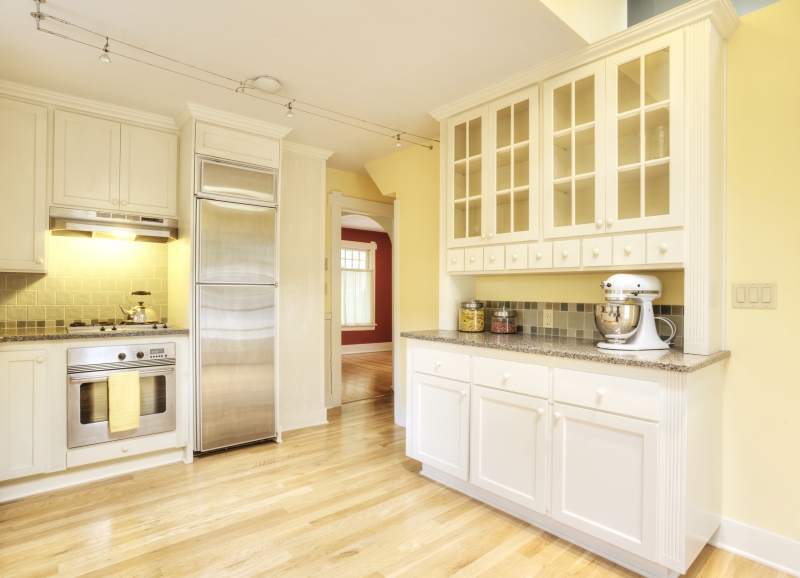
- By Bryan Uslu
- In Build, Repairs
Affordable, Durable, and Stylish Laminate Flooring
Why Choose Laminate Flooring?
Laminate flooring is a fantastic alternative to traditional hardwood or stone, offering a range of benefits range of design options that mimic the appearance of natural materials like hardwood and stone. Whether you’re remodeling a single room or your entire home, laminate flooring is a practical and stylish option to consider. In this guide, we’ll cover everything you need to know about laminate flooring, from its benefits and types to installation and maintenance.
-
Cost-Effective: Laminate is one of the most affordable flooring options available. It delivers the look of more expensive materials like wood or tile without the hefty price tag.
-
Durability: Laminate flooring is incredibly durable and resistant to scratches, dents, and stains. It’s ideal for high-traffic areas like living rooms, kitchens, and hallways.
-
Variety of Styles: With modern printing technology, laminate flooring can closely mimic the appearance of natural materials like oak, walnut, or even stone. You can find a laminate style to match almost any decor.
-
Easy Installation: Most laminate flooring is designed with a click-and-lock system, making it easier to install than hardwood or tile. Many homeowners can even tackle it as a DIY project.
-
Low Maintenance: Laminate is easy to clean and maintain. Unlike hardwood, it doesn’t require sanding or refinishing, and regular sweeping or vacuuming is usually enough to keep it looking great.
-
Eco-Friendly Options: Some laminate flooring products are made from recycled materials and are more environmentally friendly than harvesting natural wood.
Types of Laminate Flooring
When choosing laminate flooring, it’s important to understand the different types available. The primary differences come down to the core material and how the laminate is installed.
-
High-Pressure Laminate (HPL): HPL is known for its strength and durability. It’s made by fusing several layers of material under high pressure, making it more resistant to impact and wear. It’s ideal for commercial spaces or high-traffic areas in the home.
-
Direct Pressure Laminate (DPL): DPL is more common for residential use. It’s made with fewer layers but still offers durability and a realistic wood or stone appearance at a more affordable price.
-
Water-Resistant Laminate: If you’re installing laminate in areas prone to moisture, like kitchens or basements, look for water-resistant or waterproof laminate flooring. These products are specially designed to handle spills and moisture without warping or buckling.
-
Textured or Embossed Laminate: To achieve a more realistic look and feel, some laminate options are textured or embossed to imitate the grain and texture of natural wood or stone.
Step-by-Step Guide to Installing Laminate Flooring
One of the key reasons laminate is so popular is because of its relatively simple installation process. Most laminate flooring is designed to float, meaning it doesn’t need to be glued or nailed to the subfloor. Here’s a general guide on how to install laminate flooring:
-
Prepare the Subfloor: Before you begin, make sure the subfloor is clean, dry, and level. Laminate can be installed over various subfloors, including plywood, concrete, or even existing flooring like vinyl or tile, as long as it’s smooth and stable.
-
Acclimate the Laminate: Allow your laminate flooring to acclimate to the room’s temperature and humidity for 48 hours before installation. This will help prevent any expansion or contraction after it’s laid.
-
Install Underlayment: Most laminate flooring requires an underlayment, a thin foam or felt layer that provides cushioning and soundproofing. Some laminate products come with pre-attached underlayment, making this step easier.
-
Start with the First Row: Begin by laying the first row of laminate along the longest wall in the room. Leave a small gap (about ¼ inch) between the flooring and the wall to allow for expansion. You can use spacers to ensure even spacing.
-
Click and Lock: Laminate flooring uses a click-and-lock system, meaning you’ll simply click each piece together along the edges. Align the boards and press them down to lock them into place. Continue across the room, staggering the seams for a more natural look.
-
Cut to Fit: When you reach the edges of the room, you’ll likely need to cut some boards to fit. A jigsaw or circular saw can easily cut laminate flooring.
-
Install Trim and Molding: Once the laminate is laid, remove the spacers and install baseboards or molding to cover the expansion gaps around the perimeter of the room.
Laminate Flooring Maintenance
One of the best things about laminate flooring is how easy it is to care for. With just a few simple steps, you can keep your laminate floors looking like new for years to come:
-
Regular Cleaning: Sweep or vacuum your laminate floors regularly to remove dust, dirt, and debris. Use a vacuum without a beater bar to avoid scratching the surface.
-
Mop with Care: Laminate floors should not be saturated with water, as excessive moisture can seep into the seams and cause warping. Instead, use a damp (not wet) microfiber mop with a mild cleaner specifically designed for laminate floors.
-
Use Felt Pads on Furniture: To avoid scratches, place felt pads under the legs of chairs, tables, and other furniture. This is especially important for high-traffic areas where furniture is moved frequently.
-
Avoid Harsh Chemicals: Do not use harsh cleaning chemicals, abrasive scrubbers, or steam cleaners on laminate floors. These can damage the protective layer and cause the surface to dull over time.
-
Clean Spills Immediately: Although many laminate floors are water-resistant, it’s essential to clean up spills as soon as they happen. Standing water can damage the floor, especially in areas with seams or gaps.
Design Ideas for Laminate Flooring
Laminate flooring can be used in almost any room of the house, offering a wide range of design possibilities. Here are some creative ways to incorporate laminate flooring into your home:
-
Living Room Elegance: Choose a laminate that mimics the look of hardwood for a warm, inviting living room. Wide planks in a rich wood tone can make the space feel luxurious without the high cost of real wood.
-
Modern Kitchen: Water-resistant laminate is perfect for kitchens. Opt for a light, neutral shade that complements your cabinetry and countertops for a modern, sleek look.
-
Cozy Bedrooms: Laminate flooring is an excellent choice for bedrooms. Choose a wood-look laminate in softer tones like oak or maple to create a cozy, serene environment.
-
Patterned Flooring: For a unique touch, consider using laminate tiles or planks in a herringbone or chevron pattern. This can create a visually stunning focal point in a hallway, entryway, or dining room.
-
Rustic Charm: Textured or hand-scraped laminate flooring can give your home a rustic, farmhouse feel. Pair it with reclaimed wood furniture and natural decor elements for a warm, inviting atmosphere.
Conclusion
Laminate flooring is an excellent choice for homeowners looking for a durable, affordable, and stylish flooring solution. With its wide range of designs, ease of installation, and low maintenance requirements, laminate can transform any room in your home. Whether you’re looking to update your living room, kitchen, or bedroom, laminate offers a versatile and practical option that delivers both beauty and performance.
I





